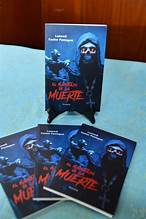Verse and prose in a literary experiment facing irreversible destiny
“Death is something we should not fear because, while we are, death is not, and when death is, we are not.” (Antonio Machado)
The Manotazo of Death, based on its name, is a striking title that largely portrays the spirit of the author, the professor, journalist and writer. Luesmil Castor Paniaguaand his assiduity in exploring landscapes where death has left its mark, at least that is what some of his works demonstrate.
Let’s see, in 2020 El Ojo del Hechizo was published, and in this work we find a series of stories that portray what I am referring to. El Ojo del Hechizo is one of the books, and be careful if the most important one from the Dominican Republic, that most shows the aspect of magical-religiousness. The variety of topics that these stories deal with have the magical-religious issue at their very core.
It is that in magical religion there is this approach to death. An approach that comes from different angles; one connected with pain, in the face of a phenomenon that, despite being so common, we feel as strange; despite being so natural, we do not prepare ourselves to expect it in an acquaintance or family member, or in ourselves. So natural, so natural, and sometimes we live as if it were not constantly lurking around the corner. So natural, that we live oblivious to it, although the simple fact of living is to lead us irremediably into its arms.
But back to the subject, The Slap of Death also expresses part of the nature of its author to recognize, value, and revere all the beings around him, who have some intangible, immeasurable and invaluable wealth. It is enough to verify how the author himself part of his family treasures to whom he dedicates this work: his wife, Maritza Salomón, Baby, as he affectionately calls her, and his children: Ithiel and Habeerlyn, and logically, the new treasure of the family, the granddaughter, Lhya.
It is not only in the family environment that the author tends to these tributes. We must see some of his works, such as his participation in anthologies. What are these valuable efforts, if not recognition of people who have contributed in the literary field to the national culture. Examples of the above: Anthology of Poetry Yumera, 1983; the author in association with other writers from his town, Yuma, converge in this collective work as anthologized. Thus we find his productions in other books, such as The Anthology of Poetry of the Crisis, included, 1985.
Thus he follows the same behavioral pattern when he publishes his work: ‘Mama Tingó in Water Tremor’, where she takes the Dominican peasant leader murdered in November 1974 as a central character, in a poem that transcends the national and crosses the ocean to reflect other Mamás Tingó from different parts of the world. Her verses sing to her, cry for her, shout at her, demand, demand, paint realities where women of the earth are the center of persecution, death, mistreatment, becoming a symbol of realities that should not exist on our planet. But Luesmil does not make these women martyrs, but muses, goddesses, who inspire us.
Part of this respectful and appreciative treatment is reflected in other works such as La Sombre Homicida, 2022, where he compiles and publishes the stories of the writer from New York, Ángel Hernández Acosta. In other words, the author does not stop at sacrificing time and effort to try to value our national writers. But he also transcends the homeland, crosses the seas and crosses time to cast a different look at the Great Ezra Pound, October 30, 1885 – November 1, 1972, American poet and critic. expatriatean important figure in the movement of modernist poetryHis evaluative action is more than reflected in how he treats this author of another nationality and another language in his essay.
Now, with the publication of El Manotazo de la Muerte, Castor Paniagua first captivates us with a title that we all feel attracted to in some way, because death is a threat that looms over any living being. In the case of human beings, it impacts us more deeply, because that blow has taken a loved one in its clutches or simply stalks us, hurts us or turns our path to the nefarious reality into an odyssey.
However, Castor is so barbaric that he dedicates the work not only to his family and departed friends, but also to friends, acquaintances and colleagues who were or are in some way linked to him or who have impacted literature through their pen. This is expressed in the dedication In Memoriam.
Pay attention to his introduction, where he says: “And it is that death, when it hits us with that unstoppable blow that destroys and violates existence, leaves us with a spiritual void, an unfillable void that boils within us like lava from a volcano…”. However, it is in that same introduction as, aware of the crudeness of this topic, he requests: “For that reason, family, friends, writers, journalists, colleagues in classrooms at the time, and why not, simple acquaintances in the distance run through those pages where feeling and narration will make us reflect on the reality of death in the trade of living.” It means, according to the author’s words, that living is heading down that irreversible route, where death awaits us with its final blow.
What does the work propose to us, what does it tell us, what appeal does it present to us? How does the author stamp his mark? Well, he says that it is a novel, he says that it is an experimental novel, in which he gathers in approximately 86 pages, a hybrid between prose and verse, and in that hybrid the author puts his particular stamp: in the sentence constructions, the paragraphs, the linguistic registers that he uses and connects in a prose-verse, verse-poetry, raw story-literary story scaffolding, with what is the theme. Not a blow of death from death itself. But a blow of death from the feeling of friendship and familiarity with the real characters who passed on to that other reality.
In his analysis, questioning or reflection on death he is accompanied by great authors, see these fragments of his work:
But it is rare.
Usually death is just a sad-faced child
A child who comes out of the night for no reason, without fear, without fervor
a poor old child who lets his hand fall on my heart.
More or less death, Mario Benedetti
Does dust return to dust?
Does the soul fly to the heaven?
Is everything without spirit,
rot and slime?
I don’t know, but there is something
that I can’t explain,
something that disgusts
Although it is necessary to do so,
leaving so sad,
only the dead.
Rhyme LXXIII, Gustavo Adolfo Becquer
So much pain is gathering in my side
that because it hurts, even my breathing hurts.
A hard slap, a cold blow,
an invisible and murderous axe blow,
a brutal push has knocked you down.
Excerpt from “Elegy to Ramón Sijé” , Miguel Hernandez
In El Manotazo de la Muerte, a variety of characters zigzag, and these are instruments for the narrative thread, where the author mixes a reflection on life-death, death-life and in prose format or in verse format, pain is expressed or the passages where death is the protagonist or unbeatable villain are questioned. In the background we find a Castor giving an inconclusive goodbye that Covid 19 cultivated with anguish, with loved ones gone before, gone during or gone after.
The structure itself and the titles of its chapters are coordinated and cohesive with the type of work, which can be seen from the dedication and the introduction. Qué hacer, Pensar and Sentencia are recurring titles, and the work closes with Carta a mi padre Luis Emilio Paniagua Perozo. This final chapter is a kind of elegy where the literary language reinforces the content and the characteristic of the book. Here we enjoy the mastery in the use of language and its ability to transmit thoughts in the prose format: ´´Thus your departure took place before the celestial gods, already with time fading in your eyes, those same ones with whom you saw the world with the honor of the surnames stamped on the face of history´´. In addition, it demonstrates its mastery in poetics, without losing coherence with the thread that runs through the entire book:
There are blows in life, so strong…
I don’t know!
Blows like the hatred of God;
as if before them,
the hangover of all the suffering
would pool in the soul…
I don’t know!
Your son Beaver, May 2018
This literary experiment is a recognition of those who have passed away, but also a reflection for those of us who are still here. It invites us to see, receive and enjoy the gift of life from another angle, reminding us of our fleeting and ephemeral stay on this earth.
“I am not afraid of death, what I am afraid of is the trance, the going there. I confess that I am curious to know what it is all about.” (Atahualpa Yupanqui)
By;- Saurys Ramírez, journalist


















